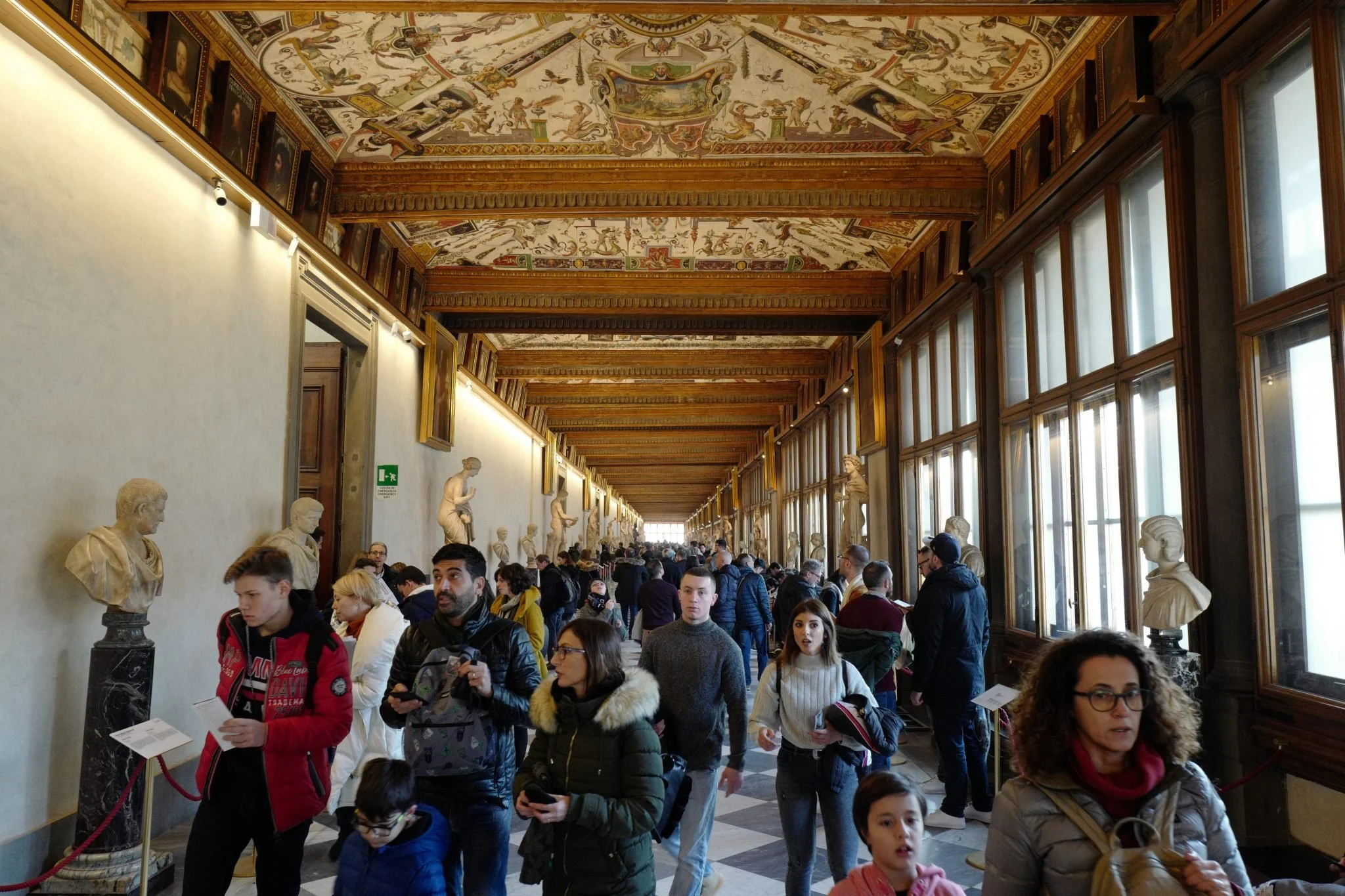Mastering The Art of Satisficing
I recently travelled to Florence with my girlfriend and I couldn’t help make a few observations.
Florence, the birthplace of the renaissance, the capital of Tuscany, is one of the most aesthetic places in Italy (which depending on who you ask, is the most aesthetic place in the world), and apparently, every interchangeable American college girl knows it. Florence, unfortunately, has become a victim of its own success; with a population a little under 300,000, the city is the 4th most visited city in Italy as it welcomes a staggering 9 million visitors every year, and it shows.
Florence: it’s Chocka
The streets are full of tourists everywhere you go, but 2 places in particular highlight the clustering rather brilliantly. The Uffizi gallery, and the Galleria dell’Accademia, the number one and two most visited galleries in Italy, respectively. The Uffizi has over 40,000 pieces of renaissance art and ancient Roman sculptures purchased by the Medici family during the height of its power. Most of the works of Michaelangelo and the other Teenage Mutant Ninja Turtles can be found here. It’s a staggeringly beautiful building with a collection of epic proportions, and herein lies the problem. Let’s park aside for a moment the jostling with mouth breathers, ducking under tour groups with selfie sticks, and school kids goofing around in the opulent corridors; I do wonder is there perhaps something else which may be precluding enjoyment here? Is there such a case of too much of a good thing?
Galleria Uffizi: Not much room to swing a cat
Galleria dell’Accademia: All eyes on the David
There are more artefacts of beauty here than anyone could truly appreciate in one lifetime, and as one walks through the grand corridors, room to room being bombarded with beauty, you can’t help but be desensitised to it all. Suddenly, once you’ve seen the 18th painting of one of the greatest painters of all time, it doesn’t quite hit as strongly. I think galleries and museum highlight the dangers of hyper-competition; some of the most beautiful things ever constructed can seem a bit shit if they’re beautiful thing number 2835 in a room. And yet, if you were to move the same item to somewhere else, let’s say a pub, people would spend hours talking about it, and even visit the pub especially to see it. Beauty can be everywhere, fame cannot. This is why when you’ve only got a limited time, you’re going to go find Michaelangelo's The David, Botticelli's Birth of Venus, and Caravaggio’s Medusa, skim the rest and then you sod off to a bar for some reasonably priced Chianti.
Leonardo Da Vinci’s The Adoration of the Magi: Could single-handedly turn around the fortunes of a failing pub.
We can talk security issues and preservation concerns, but it does seem rather insane that collectively we decided that the most beautiful things humanity has produced should all be locked away in one place, ironically put there to be appreciated, but the very place is so saturated that it becomes easier to ignore.
The Galleria dell’Accademia is an even worse culprit; once you’ve gawked incredulously at the sheer size and meticulous detail of the abs of Michaelangelo’s The David, the hallway leads to an imposing room full of plaster cast busts by Bartolini, from Greco-Roman gods and philosophers, to latter figures like Napoleon or Machiavelli. The problem? Many of the busts are the best part of 5m up on a 4th shelf, far beyond anyone’s capacity to see. Thus you have an absurd situation where priceless artefacts are placed as such that the only way to observe them would be to form a human pyramid (or a use a ladder, I’m easy). And so it seems a place laid out with the aim of maximising art and culture tries its best to minimise your appreciation of said culture.
Gipsoteca Bartolini: Made for NBA players.
So now that we’ve established that beauty has a point of diminished returns, what can be done whilst we’re waiting for Da Vinci’s The Adoration of the Magi to be moved to the local Wetherspoon’s?
Enter Satisficing. Taking the words Satisfy and Suffice, you aim for an outcome which may not be the most optimal, but will still give a degree of satisfaction. In medicine, this would be known as the minium effective dose. Going to the most visited gallery in Italy is going to cost you 30 Euros, you will be mauling your way through a scrum of tourists, and there will be more objects than your brain can process. In this instance, the strategy i.e. going to the most famous gallery, is optimised for fame, but not necessarily for an enjoyable experience.
An hour train journey to the north-east of Florence lies Bologna, the number 17th most visited city in Italy. Known as the food capital of Italy, Bologna is a pedestrian paradise, with its intricate porticoes linking most of the buildings in the historic centre, it creates an impression of walking through one giant open air house. Domineering over the town square is the basilica San Petronio, a magnificent renaissance era church.
Bologna: One Assassin’s Creed away from going viral.
With a capacity of 28,000, it’s the 10th largest church in the world, the largest made from bricks, and the interior is not drastically smaller than Florence’s Santa Maria di Fiore (30,000). It boasts a beautiful collection of renaissance and baroque art, plus a rather controversial fresco depicting the Prophet Muhammed being devoured by demons, and a meridian line cutting right through the church, designed by the astronomer Cassini to prove Kepler’s law of planetary motion. All this without having to wait in an obnoxiously long queue to go in. Is it as beautiful as Santa Maria di Fiore? Probably not if put to a vote, but will it offer as just as a pleasant experience without the queue? I’d say so. Cool shit is everywhere, but we become fixated on the best known, as if it were the only option.
Santa Maria di Fiore in Florence: Better out than in.
Satisficing is about getting as most of the positives of something with as few of the drawbacks.
Do you love the taste of champagne? A South African sparkling will taste pretty much as good without burning a hole in your pocket. Want to see the ruins of Pompeii but don’t want to walk for 6 hours? Go to Herculaneum, it’s smaller and you can go inside more buildings. Is a supermarket delivery going to pick out as good as produce as you? Probably not, but good enough to save you time and fulfil your needs. Satisficing is a compromise, it’s an acceptance that the pursuit of the most optimal… is sometimes sub-optimal. Being at peace with “good enough” is a liberating feeling, and frees up so much mental energy to appreciate life.
Herculaneum: Good enough.
Satisficing can perhaps be traced to Epicureanism. Wrongly mistaken for hedonism and maximising pleasure, Epicureanism actually advocates the moderation of pleasures to achieve the best well being. For example, drinking wine is pleasurable, but a hangover is not, so the best experience is drinking enough to enjoy it and no more. Similarly in wealth, Epicurus quipped “A man is rich when he says he has enough”. Maximising money making at the cost of everything else can be detrimental to your health if comes at the cost of quality sleep, or exposes you to increased stress from risky ventures. Warren Buffet is technically not the most successful investor of all time; there are investors with a much higher average annual return. What marks Buffett out is his longevity; he’s perpetuated a more than 70 year career with an average of 20% annual returns. Interestingly, unlike many publicly traded companies Berkshire Hathaway does not pay dividends to its investors, instead reinvesting the profits back into the company’s operations. Are there investments which could potentially generate more than 20% returns? Of course there are, could paying dividends make stock more attractive to potential shareholders and increase their share price? Potentially.
But such steps would likely increase risk, and therefore, stress. In a message to shareholders, Buffett said “when forced to choose, I will not trade even a night’s sleep for extra profits.”
Cosimo Medici: Definitely not a satisficer.
If maximising income comes at the cost of a commute that would rival the odyssey, little time to see friends and family, and a deterioration in health, then is it really the optimal outcome? Satisficing looks at the pluses and minuses in aggregate instead of in isolation. Thus a satisficed decision may seem sub-optimal in isolation but optimal when put together with everything else.
Take health - it is not that certain lifestyle choices are necessarily optimal for our health, but there may be secondary effects at play. For example, people who consume alcohol moderately on average live longer than those who don’t. Alcohol, in itself is clearly damaging to health (the benefits of red wine are incredibly exaggerated, you’d need to drink enough red wine to kill an elephant every day in order to extract enough antioxidants). However, alcohol is typically consumed socially, and regular face-to-face interactions has very powerful health benefits, such as alleviating stress. And it may be that the absence of stress has a much stronger impact on health outcomes than whatever the alcohol is doing. Thus something which appears sub-optimal in the short term may in fact be optimal in the long-term.
Wine: Satisficingly healthy
Satisficing can feel like a shitty compromise when we’re encouraged to find the best in everything we see or do, but if you’re willing to go against conventional wisdom and seek out the lesser contested hills, you can enjoy them all to yourself.
So here’s to the 12th best; I wouldn’t settle for anything less!
P.S. If you insist on going to Santa Maria di Fiore but don’t want to queue for an hour, just dress a little smarter and go to Sunday Mass; no queue, just walk right in!










